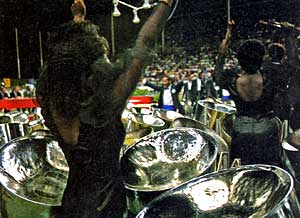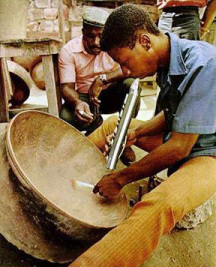In Trinidad, Beating the Steel Drums of War
By Stephen Brookes
in Port-of-Spain for Insight Magazine
It was shaping up to be a very tough fight. The Witco Desperadoes' version of Tchaikovsky's "Marche Slave" was powerful, and they’d won Trinidad and Tobago's last national steel band competition.
But their rivals, the Solo Harmonites, were weighing in with a smooth, elegant reading of Wagner's "Rienzi" overture. And a feisty dark horse called the Tropical Angel Harps had wowed the judges in the semifinals with a shimmering performance of Rimsky-Korsakov's "Scheherazade.” At the battle that night in the national stadium, the bands would be coming out with all drums blazing. 
Stephen BrookesIn the end, though, after a grueling 10-hour competition that ended in the small hours of the morning, the 60-man Desperadoes won the fifth Pan Is Beautiful Festival in Port-of-Spain -- winning glory, a North American tour and a chance to perform at Carnegie Hall.
But they also became the representatives of what this Caribbean island nation increasingly sees as its most important contribution to world culture: music.
Steel band music -- or “pan” music, as it’s properly known -- is not taken lightly in Trinidad. Every Trinidadian has his favorite band, whose ups and downs are followed passionately by everyone from Cabinet ministers to the peanut sellers in the side streets of Port-of-Spain.
The instruments themselves, which are made from old oil drums and are capable of an astounding range of pitches and sonorities, have become increasingly sophisticated, and playing them has developed into a fine art. Popular pannists enjoy the status of rock stars, the tabloid headlines scream rumors about their romances, and at Carnival time the excitement turns into fever as thousands of fans take to the streets to dance all night to the pan.
But the pan is also starting, slowly, to gain recognition in the rest of the world as a serious instrument, one that can hold its own in almost any musical setting and can legitimately be used to interpret even the Western classical repertoire.
"The stereotype of pan music is happy black man with nice white teeth, straw hat and banana shirt playing 'Yellow Bird' and 'Island in the Sun,'” says Richard Murphy, one of the festival's judges. "That's 30 years out of date."
Easley Blackwood. a music professor at the University of Chicago who has been a judge at the festival since 1984, agrees, complaining that his colleagues in the U.S. music world do not take pan seriously enough.
"They do not realize that it really is high-class music making, very accurately and beautifully played, and getting more sophisticated all the time,” he says.
Pannists trace the steel band's roots to the late 19th century, when informal bands would make music by banging different lengths of bamboo -- known as tambo-bambos -- on the ground to produce percussive tones. Despite suppression by the British colonial government, which worried about the music's political overtones, tambo-bambo bands flourished well into the 1930s.
But it wasn’t until U.S. naval forces pulled out of Trinidad in 1945, leaving behind thousands of empty oil drums, that the pan itself was invented.
Despite a great surge of popularity throughout the country, the instrument continued to enjoy official disfavor as being noisy and disreputable. associated with troublemakers and anti-colonial rabble-rousers. An anti-pan law was passed in 1949, giving the police the freedom to smash the drums and arrest anyone caught playing them. But the easy availability of the drums made it impossible to wipe them out.
www.seetobago.com"The pan was created by the society's rejects," says Arnim Smith, president of Pan Trinbago, the group that represents the country's steel bands. "And it was a struggle against the police, against the judges, against everybody. But the determination was there. We created something, and we just could not let it go."
Smith believes that the official suppression bred further violence among the bands through most of the 1950s. Fist fights would break out when gangs of pannists, wearing the drums around their necks, met each other in the streets. To contain and channel the violence, the first steel band competition was set up in 1962, and the festivals are now held every two years. The players welcome them.
"If it weren't for these competitions, a lot of the bands would hardly be heard," says Fitzroy Innes, leader of the Tropical Angel Harps.
The festivals have also pushed pan music well into the mainstream. There are more than 130 pan orchestras in Trinidad and Tobago, with as many as 50,000 players around the country. Steel bands play everywhere from churches to clubs to the Port-of-Spain Hilton, and the players come from all walks of life.
"The band is a wide cross section of the society,” says Innes. "We have professional people, government employees, teachers, students. trades people.”
Steel bands come in various configurations, but a full-size orchestra will involve 30 to 100 pannists, each playing up to nine different drums. The highest-pitched pans (known as the front-line pans) are the tenors and double tenors, which carry the melody. They’re backed up by increasingly larger and deeper pans - the double seconds, the treble guitars and the cellos - which fill out the harmonies.
A relatively new pan called the quadraphonic provides a deeper voice, while the lowest pans, known as the tenor bass and the six bass, are full-size drums that carry the bass line. The band is finished off with a standard percussionist, sometimes reinforced with gongs, tambourines and other instruments.
Despite improvements and refinements over the years, most pans are still made as they were in the 1940s, by cutting down standard 42-gallon oil drums and hammering small, resonant domes into the surface, creating up to two dozen separate pitches.
But pan makers are no mere bangers. Every oil drum is considered distinct: Different alloys result in different sonorities, and a maker will carefully test a particular drum before it is earmarked as a high- or low-pitched pan.
Jaime OstercampTesting the sound of the drum surface with a small hammer, the pan maker will fit the placement of the notes to each particular drum. The surface of the drum is then "sunk" with a sledgehammer, and the individual notes "hammered up" from below into shallow domes - a process known as "ponging up" the pan. After tempering in an open fire and a final tuning, the pan is ready for play.
The result is a handmade instrument with an individual sound; an orchestra will have a well-blended sound only if the pans are made and tuned by the same tuner. That, plus the different tuning systems used, has created problems: Two orchestras that had planned to come to this year's festival from Sweden and Britain, for example, had to pull out due to the high cost of transporting their instruments. Standardizing the instruments and their tuning remains a controversial matter.
Playing classical music on the pan has been necessary to secure its stature as a modem musical instrument, pannists say, but it also has shown just how broad and colorful the steel band's musical palette really is. From delicate, shimmering passages that suggest the ethereal sound of a glass harmonica, to detailed counterpoint, intricate passagework and thundering, unstoppable percussive crescendos, the sound of a full-size steel orchestra is, in a word, extraordinary. It has an uncanny ability to evoke the sound of trumpets, woodwinds, even strings. Ringing with complex harmonics, the sound is almost hypnotic.
Says Jerry Jemmott, who has led the Solo Harmonites on tours around the world, “Audiences who hear pan orchestras in Europe can't believe we're getting all these different tones from it. They come up and look around for wires: They think we're using a synthesizer."
Given the unique sound of the steel pan, however, the choice of music is critical. Although works as complex as Stravinsky's "The Rite of Spring" have been played in the past, most choices come from the classical and romantic eras. "Atonal, dissonant music is not successful on pan," says Blackwood. "It just degenerates into confusion. What they are best at - aside, of course, from the calypso - is the big, splashy 19th-century pieces that modulate all over the map "
And the bands have been ambitious. Among this year's pieces were selections from "The Planets" by Gustav Holst, "La Forza del Destino" by Guiseppe Verdi, selections from Richard Wagner's "Me Flying Dutchman" and works by Mozart, Rossini and Aaron Copland.
The music is played entirely from memory. Often only one or two members of the steel band will be able to read music; they’ll play the notes directly off a miniature score, assigning parts on the basis of range, and each player will memorize his part. The whole process takes about six months to bring a piece to readiness.
"We have a core of about 20 really sharp guys," says Clarrie Benn, an official with Trinidad's Central Bank who also manages the Tropical Angel Harps.
"They'll work the tune over and then teach it to the slower ones. That way we can move much faster, instead of starting from scratch with the full orchestra."
While the classical repertoire lends the bands legitimacy, the groups really seem to come alive when they play the traditional Caribbean calypso. New tunes are generated every year for Carnival, and the most popular are soon arranged for pan orchestra. With their lilting melodies, their mix of African, Indian and Spanish cultures and their irresistible rhythms, calypsos are uniquely West Indian.
"The calypso gives you freedom," says one player. "There’s a driving force in it," agrees the Harmonites' Jemmott. "You couldn't stand at attention and play this music. You just got to bounce!"
Acceptance is still an uphill battle. But as more bands tour and record, and audiences become familiar with the music, promoters expect that the steel band's appeal will grow. Such well-known pop and jazz stars as Paul Simon, Aretha Franklin and Monty Alexander have used pans in recent recordings, and steel band promoters confidently predict that this is just the beginning.
"We're going to diversify the music," says Simeon Sandiford, who has recorded most of Trinidad and Tobago's steel bands. "The culture is so rich. We're working with jazz musicians, with Indian musicians, everything." Sandiford recently released the first steel band compact disc earlier this year on the Delos label and thinks the future is bright.
"We're ready to take on the world," he says. "No doubt about it."
(Insight Magazine, December 8, 1988)
References (6)
-

-
 Response: is ninjaessays reliableThis is very good idea by the school management to come up with new way of teaching style for the students. Generally we see teacher teach about any subject in the classroom. But, this is making the students to be virtually present in that place and know about that continent which ...
Response: is ninjaessays reliableThis is very good idea by the school management to come up with new way of teaching style for the students. Generally we see teacher teach about any subject in the classroom. But, this is making the students to be virtually present in that place and know about that continent which ... -
 Response: response essay sample
Response: response essay sample -
 Response: Vete LyricsVete Lyrics by Kim Loaiza is latest Spanish song voiced by him, its music is given by Elvis de Yongol, Gotex, MK En El Beat. Brand new lyrics of Vete song is written by Kim Loaiza, Elvis de Yongol, Gotex, MK En El Beat, Sofía Iveth Mayorga Enriquez, Leonardo de la ...
Response: Vete LyricsVete Lyrics by Kim Loaiza is latest Spanish song voiced by him, its music is given by Elvis de Yongol, Gotex, MK En El Beat. Brand new lyrics of Vete song is written by Kim Loaiza, Elvis de Yongol, Gotex, MK En El Beat, Sofía Iveth Mayorga Enriquez, Leonardo de la ... -
 Response: Show You Lyrics - TerriShow You Lyrics by Terri is a beautiful song which is presented here. Show You song lyrics are penned down by Terri while its tune is made by Terri.
Response: Show You Lyrics - TerriShow You Lyrics by Terri is a beautiful song which is presented here. Show You song lyrics are penned down by Terri while its tune is made by Terri. -
 Response: Mad at me Lyrics - QuadecaMad At Me Lyrics by Quadeca is a latest song. Quadeca has created its tune while brand new Mad At Me song lyrics are written by Quadeca.
Response: Mad at me Lyrics - QuadecaMad At Me Lyrics by Quadeca is a latest song. Quadeca has created its tune while brand new Mad At Me song lyrics are written by Quadeca.


Reader Comments